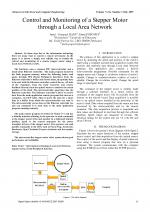| 2/2007 - 8 |
Control and Monitoring of a Stepper Motor through a Local Area NetworkJIANU, I. E., POPOVICI, D. |
| Extra paper information in |
| Click to see author's profile in |
| Download PDF |
Author keywords
information technology, local area network, stepper motor, serial peripheral interface
References keywords
References keywords will be displayed on the next page reload.
About this article
Date of Publication: 2007-11-03
Volume 7, Issue 2, Year 2007, On page(s): 33 - 36
ISSN: 1582-7445, e-ISSN: 1844-7600
Digital Object Identifier: 10.4316/AECE.2007.02008
Web of Science Accession Number: 000259903400008
Abstract
In these days due to the information technology there are many ways to control a remote servomotor. In the paper it is shown a simple and reliable way to handle the control and monitoring of a remote stepper motor using a Local Area Network (LAN). The hardware uses a common PIC microcontroller and a stand-alone Ethernet controller. The main program located in the flash program memory solves the following tasks: read packs through SPI (Serial Peripheral Interface) from the Ethernet controller's buffer and decode them, encapsulate data to be sent with the Ethernet controller, control the on-off state of the transistors from the static converter and receive feedback directly from the optical sensor to monitor the actual position of the shaft. The microcontroller supervises also the Ethernet controller. The Ethernet controller's job is to receive data from the main application remote program that runs on a computer, via UTP cable. Then it stores the data for a short time in a buffer from which the microcontroller can read it. The microcontroller stores data on this Ethernet controller too and can command it to send data to the main application program running remotely. The main remote program is written in Visual C++ and has a friendly interface allowing to the operator to send commands to the stepper motor drive and monitor in a dedicated window position, speed or the control sequences for the power transistor drivers of the stepper motor. The operator can send specific commands to the drive such as Start, Stop, Accelerate, Decelerate, Spin Clockwise/Counter clockwise and the number of steps. The microcontroller stepper motor drive system shows good performance and reliability. |
| References | | | Cited By |
Web of Science® Times Cited: 1 [View]
View record in Web of Science® [View]
Updated today
We were unable to retrieve information about this paper in SCOPUS®.
Message: [Returned results: 0]
[1] Application with a XY-plotter controlled by PLC used in student laboratory works, Rata, Mihai, Rata, Gabriela, 2015 9th International Symposium on Advanced Topics in Electrical Engineering (ATEE), ISBN 978-1-4799-7514-3, 2015.
Digital Object Identifier: 10.1109/ATEE.2015.7133684 [CrossRef]
Disclaimer: All information displayed above was retrieved by using remote connections to respective databases. For the best user experience, we update all data by using background processes, and use caches in order to reduce the load on the servers we retrieve the information from. As we have no control on the availability of the database servers and sometimes the Internet connectivity may be affected, we do not guarantee the information is correct or complete. For the most accurate data, please always consult the database sites directly. Some external links require authentication or an institutional subscription.
Web of Science® is a registered trademark of Clarivate Analytics, Scopus® is a registered trademark of Elsevier B.V., other product names, company names, brand names, trademarks and logos are the property of their respective owners.
Faculty of Electrical Engineering and Computer Science
Stefan cel Mare University of Suceava, Romania
All rights reserved: Advances in Electrical and Computer Engineering is a registered trademark of the Stefan cel Mare University of Suceava. No part of this publication may be reproduced, stored in a retrieval system, photocopied, recorded or archived, without the written permission from the Editor. When authors submit their papers for publication, they agree that the copyright for their article be transferred to the Faculty of Electrical Engineering and Computer Science, Stefan cel Mare University of Suceava, Romania, if and only if the articles are accepted for publication. The copyright covers the exclusive rights to reproduce and distribute the article, including reprints and translations.
Permission for other use: The copyright owner's consent does not extend to copying for general distribution, for promotion, for creating new works, or for resale. Specific written permission must be obtained from the Editor for such copying. Direct linking to files hosted on this website is strictly prohibited.
Disclaimer: Whilst every effort is made by the publishers and editorial board to see that no inaccurate or misleading data, opinions or statements appear in this journal, they wish to make it clear that all information and opinions formulated in the articles, as well as linguistic accuracy, are the sole responsibility of the author.



